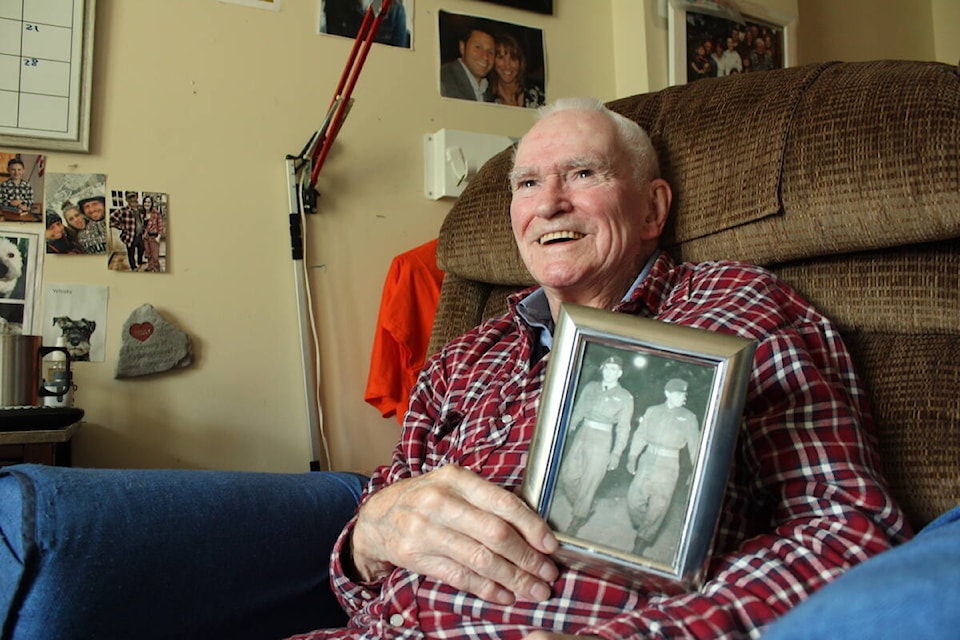After sliding down the side rails of a ladder, Roy Mackay’s boots would crash into the boiler room’s metal-plated floor with a bang.
The entirety of his shift would then be spent stoking his naval destroyer’s fires with black-tar-like bunker fuel to power the ship as it shelled North Korea or helped rescue crashed fighter pilots from the Yellow Sea amid the forgotten war.
Now the former paratrooper and navy member lives at Saanich’s Veterans Memorial Lodge, in a room where the walls are dotted with pictures of his family. Over 20 years in the navy took him all over the world, to places like Australia, New Zealand, Ireland, South America, the Pacific Islands, the Panama Canal and more.
“I had a good life, very good life in the military, I was very pleased with them.”
Mackay was born in 1930 in Montreal. He joined the military to follow in the footsteps of family members, but he also did it for the adventure. But on the day in 1948 when he signed up at the recruiting office, he didn’t realize they’d send him off to basic training that night.
“I got home and my mom said ‘How’d you make out’ and I said ‘Oh I’m away tonight,’ (she said) ‘Tonight?’” Mackay said, imitating his mother’s surprise.
At the time, there were fears of invasions from the north. Russia could make its way to Alaska and Canada in just a few hours, but transiting troops to their landing spots would take too long.
That left dropping in paratroopers as the best way to quickly fortify northern positions. Mackay had never been in an airplane when the train dropped him off at the Rivers, Man. training centre and he had no idea they’d assign him to being a paratrooper.
“Boy I tell you, I loved those airplane rides,” Mackay said. “It was really exciting, I really enjoyed that.”
He fondly remembers the military planes flying just a couple hundred feet over the prairies and looking down at the drop-jawed expressions of awestruck farmers pointing up at them.
The planes had to fly low so paratroopers wouldn’t be vulnerable to gunfire during their descent. During his training flights in Alberta, B.C., Manitoba and Alaska, Mackay would look at his watch while still on the plane and within 45 seconds he’d be on the ground.
“It was fun for a young guy,” the veteran said, noting they’d get a good laugh when a fellow trooper got tangled in their strings and would land upside down.
With one chute strapped to his back and a spare one fixed to his front, Mackay and other trainees would line up outside their aircraft before officers shouted questions like “Are you ready?” and “Are you going to jump?” – which were always met with a collective “Yeah” from the young troops.
When they approached their jumping point, the paratroopers would stand in two rows of 10 before they’d push forward and pack in tight against the aircraft’s door. Mackay noted the bigger guys were usually put at the back of the line to help cram everyone forward. Then a green light would come on, meaning it was time to go.
“You’re kind of paralyzed,” he said, chuckling, about the first drop from the plane. “It was a five-week course where they taught you how to jump out of an airplane. I don’t know why, you didn’t jump you just fell out.”
After three years, his army contract was up for renewal, but he wanted to serve in the Korean War and the navy promised him a quicker route to get there.
“(The army was) disappointed,” the 93-year-old said as he paused slightly to punctuate his perfect comedic timing, “Imagine losing me.”
He did his three months of navy training in Nova Scotia before they sent him to CFB Esquimalt and then deployed Mackay across the Pacific aboard the HMCS Athabaskan II.
They stopped for training in Hawaii on the way as Mackay’s crew fired the destroyer’s four-inch guns at targets set up on the shore.
“Every time they fired it, it broke all the light bulbs. It would make a terrible noise and shake the hell out of you.”
When they reached the Yellow Sea – which separates the Korean peninsula and China – the ship had to navigate through mines in the water that could take out the vessel’s bow. Mackay remembers how sad it was to see people suffering in Korea and it was hard for him to understand while still in his early 20s.
Their mission also included rescuing American fighter pilots who had been shot out of the sky.
Upon being safely returned to their aircraft carriers by the Canadians, Mackay said the downed pilots would be treated to mounds of their favourite ice cream.
Staying entertained was key during the long bouts at sea. For Mackay and his peers, having fun aboard the boat usually came at the expense of cranky superiors. The sailors would mess with officers by putting peanut butter on toilet seats before the higher-ups made their inspection rounds, putting fish in an especially disliked officer’s desk drawer or poking fun at the top brass in gossip columns of the ship’s paper.
After a year and a half in Korea, Mackay’s navy career saw him traverse the globe for another two decades. Among the list of his favourite places were New Zealand and Ireland, with the latter feeling like home after he grew up in an Irish district of Montreal.
But rounding out his list of favourite places was Vancouver Island, where his wife and three kids always welcomed him home after long deployments at sea.
“Oh God, they’d all be on the jetty waiting for you and the kids would be there, all excited.”
ALSO READ: Victoria veteran spent Second World War flying below the radar
